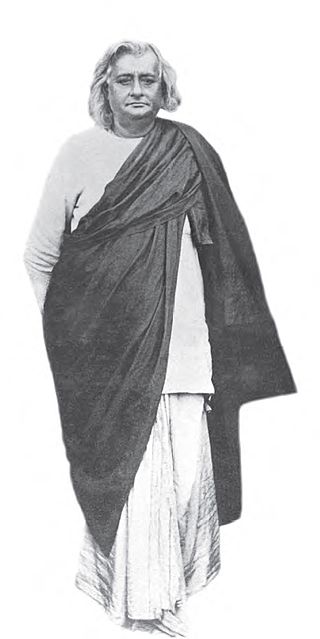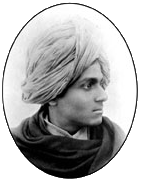
Ramakrishna Math and Ramakrishna Mission (RKM) is a spiritual and philanthropic organisation headquartered in Belur Math, West Bengal. The mission is named after the Indian Hindu spiritual guru and mystic Ramakrishna. The mission was founded by Ramakrishna's chief disciple Swami Vivekananda on 1 May 1897. The organisation mainly propagates the Hindu philosophy of Vedanta–Advaita Vedanta and four yogic ideals – Jnana, Bhakti, Karma, and Raja yoga. The mission bases its work on the principles of Karma Yoga, the principle of selfless work done with a dedication to God.

Swami Akhandananda (1864–1937) was a swami and direct disciple of Sri Ramakrishna, a 19th-century mystic. He was the third president of the Ramakrishna Mission.

Swami Shivananda (1854–1934), born Tarak Nath Ghosal, was a Hindu spiritual leader and a direct disciple of Ramakrishna, who became the second president of the Ramakrishna Mission. His devotees refer to him as Mahapurush Maharaj. Shivananda and Subodhananda were the only direct disciples of Ramakrishna to be filmed. He was a Brahmajnani. Shivananda introduced the celebration of the birthdays of his brother-monks. He was known to have laid the foundation stone of Shri Ramakrishna Temple at Belur Math, which was designed by Vijnanananda.
Swami Vireshwarananda, the tenth President of the Ramakrishna Math and Ramakrishna Mission, was born on 31 October 1892 at Gurupura, Near Mangalore, South India. His pre-monastic name was Pandurang Prabhu; he was later known as Prabhu Maharaj. After his father's death at an early age, his mother moved with them to his maternal uncle's house at Mangalore.

Swami Yatiswarananda was a vice-president of Ramakrishna Order, whose headquarter is in Belur Math. He was a disciple of Swami Brahmananda, a brother disciple of Swami Vivekananda and a direct disciple and spiritual son of Ramakrishna. He served in Philadelphia propagating the message of Vedanta. He was the president of Bangalore centre of Ramakrishna Math. He founded an ashrama in Switzerland.

Swami Virajananda, born Kalikrishna Bose, was an initiated disciple of Sarada Devi and the sixth president of the Ramakrishna Order. Born as the son of Trailokyanath Bose and Nishadkalidevi, Virajananda was the first person to join the Ramakrishna Order after the direct disciples of Ramakrishna. In 1897, he was initiated into sannyasa by Vivekananda. From 1899 onward he served in Advaita Ashrama, Mayavati and became its president in 1906. He is recognised as a monastic disciple of Vivekananda.
Swami Kirtidananda (1925-2007) was born as Srikantayya in an orthodox family at Bangalore on 25 June 1925. He had his education at National High School and graduated from Central College. He later joined the Ramakrishna Math in 1946 at its Bangalore Centre under Tyagishananda. He had mantra deeksha from Virajananda, the 6th President of the Ramakrishna Sangha and had sannyasa deeksha from Shankarananda in 1957.

Prabuddha Bharata is an English-language monthly journal of the Ramakrishna Order, in publication since July 1896. It carries articles and translations by monks, scholars, and other writers on humanities and social sciences including religious, psychological, historical, and cultural themes. It has a section of book reviews where important publications from university presses from around the world are reviewed. It is edited from Advaita Ashrama, Mayavati, Uttarakhand, and published and printed in Kolkata. Prabuddha Bharata is India's longest running English journal.

Swami Atmasthananda was an Indian Hindu monk, who was the fifteenth president of the Ramakrishna Math and the Ramakrishna Mission.

Swarupananda was a direct monastic disciple of Vivekananda and the first president of the Advaita Ashrama, set up by Vivekananda in 1899 at Mayavati, near Champawat. The ashram is a branch of the religious monastic order, Ramakrishna Math, also set up by Vivekananda on the teachings of his guru Ramakrishna.

Swami Ashokananda, born as Yogeshchandra Dutta, was a disciple of Swami Vivekananda of India and a monk of the Ramakrishna Math. From 1932 until his death in December 1969 at the age of 76 he was in charge of the Vedanta Society of Northern California, San Francisco.

Swami Yogananda was a disciple of Ramakrishna Paramahansa, the 19th-century mystic. He took his formal initiation from Sarada Devi, the "holy mother" of Ramakrishna paramhansa Order and spiritual consort of Ramakrishna. He was the first vice-president of Ramakrishna Mission. He belonged to the family of Sabarna Roy Choudhury, an aristocratic family of erstwhile Bengal. He had a very short life, but he played a very important role during the formative years of Ramakrishna Mission. He was also a dedicated and devoted attendant to Sarada Devi during her stay in Calcutta after Ramakrishna paramhangsha's death. He was one of the disciples whom Ramakrishna paramhangsha referred to as "Iswarakoti" or the "ever perfect soul".

Udbodhan is the only Bengali publication of the Ramakrishna Math and Ramakrishna Mission, started by Vivekananda in January 1899, with Trigunatitananda as its founding editor Over the years, it also grew into a publishing house, and remained one of the leading publishers of literature of Ramakrishna and Vivekananda.

Josephine MacLeod was an American friend and devotee of Swami Vivekananda. She had a strong attachment to India and was an active participant in the Ramakrishna Vivekananda movement. She was given the nicknames "Tantine" and "Jo Jo" by Vivekananda. She considered Swami Vivekananda to be her friend and helped him with his finances. MacLeod was not a sanyasin, unlike many others such as Sister Nivedita or Sister Christine. She was instrumental in spreading Vivekananda's message on Vedanta in the West. She made many contributions to the initial and the later phases of the development of the order of Ramakrishna and Vivekananda. She was a contributor to many causes espoused by Sister Nivedita, the most famous disciple of Vivekananda, including that of contributing financially towards the development of the Indian National Movement especially in Bengal and elsewhere in India.

Swami Sadananda, born Sharat Chandra Gupta, popularly known as Gupta Maharaj in the Ramakrishna Order, was a direct monastic disciple of Swami Vivekananda. He was the first disciple according to some sources. He took his monastic vows and joined Baranagar Math to serve the other disciples of Sri Ramakrishna in 1888–89 and subsequently joined the Belur Math when it was established. He was one of the leaders of early Ramakrishna Mission in its relief work. One of his significant contributions was providing relief to the citizens of Calcutta during the plague epidemic of 1898–99. He traveled to Japan in 1903. His later days were spent in company of Sister Nivedita as her protector and guide. His notable contribution in the later part of his life was preaching the message of Swami Vivekananda, especially among youth.

Charlotte Sevier, also known as Mrs. Sevier, was a direct disciple of Swami Vivekananda and was British in origin. She, together with her husband James Henry Sevier established the Advaita Ashrama in Mayavati, a branch of the Ramakrishna Order, in the Himalayas.

Nischayananda was an Indian monk who worked to help the poor and needy. He was a direct monastic disciple of Vivekananda. He, together with Kalyanananda was responsible for setting up and running the Ramakrishna Mission Sevashrama, Kankhal. He was inspired by Vivekananda's philosophy of serving man as God and dedicated his life to serve poor and downtrodden in the remote areas where no healthcare facility existed. He worked in military service before joining the Ramakrishna Order as a direct monastic disciple of Vivekananda. He met Vivekananda in Madras and decided to become his disciple. After Vivekananda's death, he went for pilgrimage and by chance came to Haridwar where he met his brother disciple Kalyanananda and joined him in carrying out the works of Ramakrishna Mission Sevashrama Kankhal.

Dhanraj Giri (1811–1901) was the abbot of Kailash Ashram, an ashram, which he established in 1880 at Muni Ki Reti, Rishikesh. It was one of the first large ashrams to be established in Rishikesh, prior to which it was mostly as a place for individual seekers, or pilgrims to stop over on way to Char Dham temples pilgrimage. He was a famous monk in Northern India and was a scholar in Vedanta philosophy. He was well acquainted with spiritual luminaries of nineteenth century India like Swami Vivekananda.

Swami Prakashananda (1874–1927) was a monastic disciple of Vivekananda and a monk of the Ramakrishna Order who played a major role in propagating and promoting the Vedanta philosophy and Vivekananda's message in India and America. He came to the US in 1906 to serve under Trigunatitananda, a direct disciple of Ramakrishna at the Vedanta Society of San Francisco, later renamed as Vedanta Society of Northern California, and later became its president.
Vimalananda (1872–1908) was an Indian spiritual writer who was one of the monastic disciples of Vivekananda and an early monk of the Ramakrishna Order. He was involved in the publication of Prabuddha Bharata. He was actively involved in running day-to-day operations of the Advaita Ashrama at Mayavati during the early days of the Ashrama. He also inaugurated the Ramakrishna Math at Ulsoor in Bangalore in 1906. He died in 1908 at the Mayavati Ashrama.























